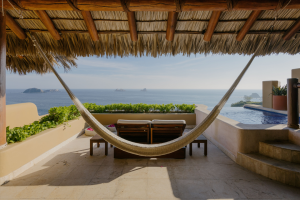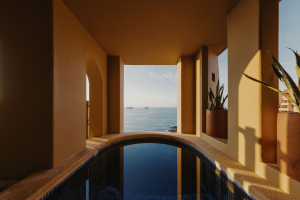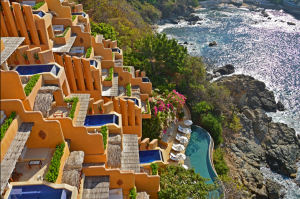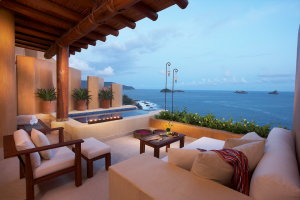The Rise of Private Pool Suites: Why Luxury Travelers Are Choosing Secluded Stays
The resort is part of a global trend reshaping luxury travel: the rise of private pool suites. No longer confined to a few ultra-luxe villas in the Maldives or Bali, private pools are quickly becoming a must-have feature for resorts around the world—and Cala de Mar is at the forefront in Mexico.
Cliffside Casitas with a View—and a Pool
Tucked into the cliffs of the Sierra Madre mountains and overlooking the Pacific Ocean, Cala de Mar is a boutique resort with just 59 suites, each one designed for seclusion. Think: no shared walls, no overhead balconies, and no peeking neighbors. It’s just you, the sound of crashing waves, and your very own infinity plunge pool.
This isn’t only about aesthetics, though the views are hard to beat. It’s about the experience of space. Each casita is carved into the hillside in a way that gives every guest the feeling of having their private sanctuary. Sizes range from a generous 580 square feet to over 1,500 square feet in the Family Adjoining Ocean Front Suites, with oversized terraces, sun loungers, and outdoor dining areas.
Add in a dedicated personal assistant, guaranteed early check-in and late check-out, and it’s easy to understand why so many guests end up extending their stay.
Designed for Romance, Relaxation, and Reconnection
At Cala de Mar, the suites are the foundation for the entire guest experience. Each one is dressed in soft neutral tones with handcrafted local décor that nods to Ixtapa’s heritage. And while all suites offer the same show-stopping views and privacy, there are subtle variations that cater to different types of travelers.
Cliffside Ocean Front Suites (580–750 sq. ft.) are ideal for couples or solo travelers, with a breezy layout and plunge pool perched right on the edge of the Pacific.
Romance Deluxe Ocean Front Suites (730–895 sq. ft.) offer a bit more space, perfect for honeymoons or anniversary escapes, with larger terraces and cozy lounge areas.
Family Adjoining Ocean Front Suites (1,350–1,550 sq. ft.) feature two adjoining rooms—each with its private pool—so families can stay connected without giving up personal space.
The Penthouse Master Suite (980–1,250 sq. ft.) sits at the highest point of the resort and offers panoramic views, a hammock lounge, al fresco dining area, and an extra-large infinity pool.
Inside, expect all the modern comforts: king-sized beds, LCD satellite TVs, air conditioning, ceiling fans, and minibars stocked with complimentary drinks. But it’s the sound of the waves and the sheer openness to nature that guests remember most.
Not Just a Room. A Whole Experience
Even though the suites are reason enough to stay put, Cala de Mar offers plenty more. Theon-site El Capricho Spa invites guests into a world of wellness with rituals and treatments inspired by local healing traditions. Morning yoga sessions are held on a clifftop platform.
When it’s time to dine, guests can choose from several on-property venues. There’s an elegant seafood restaurant carved into the rock with panoramic views, a cocktail bar that turns into a front-row seat for sunset, and options for private dining right on your terrace.
It’s this kind of flexible, guest-centric approach that makes Cala de Mar more of a retreat thana resort.
Why Private Pool Suites Are the Future of Travel
The growing popularity of private pool suites is no coincidence. They offer the perfect balance of indulgence and intentionality, which is something increasingly important to post-pandemic travelers who value wellness, solitude, and meaningful experiences. Guests are no longer content to simply visit a destination. They want to feel immersed in it.
Cala de Mar checks all the boxes. From the moment guests arrive, they’re surrendering to stepping out of the hustle. No crowds, no rushed itineraries. And in a world where true disconnection is hard to find, that’s what sets Cala de Mar apart.
Juan C Lopez Flores
ENroute Communications
+1 917-438-7096
email us here
Visit us on social media:
Facebook
X
Legal Disclaimer:
EIN Presswire provides this news content "as is" without warranty of any kind. We do not accept any responsibility or liability for the accuracy, content, images, videos, licenses, completeness, legality, or reliability of the information contained in this article. If you have any complaints or copyright issues related to this article, kindly contact the author above.
2D Heterostructures Market is Expected to Reach a Valuation of USD 2,359.2 Million in 2035, States Fact.MR
Automotive Intelligence Battery Sensor Market Size, Share & Trends Analysis Report By Product
Automotive Headliner Market - Opportunities, Share, Growth and Competitive Analysis and Forecast 2029
Więcej ważnych informacji
 Jedynka Newserii
Jedynka Newserii

 Jedynka Newserii
Jedynka Newserii

Konsument

Polacy nie korzystają z hossy trwającej na warszawskiej giełdzie. Na wzrostach zarabiają głównie inwestorzy zagraniczni
Od października 2022 roku na rynkach akcji trwa hossa, nie omija ona także warszawskiej giełdy. Mimo to inwestorzy indywidualni odpowiadają zaledwie za kilkanaście procent inwestycji, a o wzrostach decyduje i na nich zarabia głównie kapitał z zagranicy. Widać to również po napływach i odpływach do i z funduszy inwestycyjnych. Zdaniem Tomasza Koraba, prezesa EQUES Investment TFI, do przekonania Polaków do inwestowania na rodzimej giełdzie potrzeba zysków z akcji, informacji o tych zyskach docierającej do konsumentów oraz czasu.
Polityka
Obowiązek zapełniania magazynów gazu w UE przed sezonem zimowym ma zapewnić bezpieczeństwo dostaw. Wpłynie też na stabilizację cen

Unia Europejska przedłuży przepisy z 2022 roku dotyczące magazynowania gazu. Będą one obowiązywać do końca 2027 roku. Zobowiązują one państwa członkowskie do osiągnięcia określonego poziomu zapełnienia magazynów gazu przed sezonem zimowym. Magazyny gazu pokrywają 30 proc. zapotrzebowania Unii Europejskiej na niego w miesiącach zimowych. Nowe unijne przepisy mają zapewnić stabilne i przystępne cenowo dostawy.
Infrastruktura
Gminy zwlekają z uchwaleniem planów ogólnych zagospodarowania przestrzennego. Może to spowodować przesunięcie terminu ich wejścia w życie

Reforma systemu planowania i zagospodarowania przestrzennego rozpoczęła się we wrześniu 2023 roku wraz z wejściem w życie większości przepisów nowelizacji ustawy z 27 marca 2003 roku. Uwzględniono w niej plany ogólne gminy (POG) – nowe dokumenty planistyczne, za których przygotowanie mają odpowiadać samorządy. Rada Ministrów w kwietniu br. uchwaliła jednak ustawę o zmianie ustawy z 7 lipca 2023 roku, a jej celem jest zmiana terminu obowiązywania studiów uwarunkowań i kierunków zagospodarowania przestrzennego gmin na 30 czerwca 2026 roku. Wskazana data może nie być ostateczna z uwagi na to, że żadna z gmin nie uchwaliła jeszcze POG.
Partner serwisu
Szkolenia

Akademia Newserii
Akademia Newserii to projekt, w ramach którego najlepsi polscy dziennikarze biznesowi, giełdowi oraz lifestylowi, a także szkoleniowcy z wieloletnim doświadczeniem dzielą się swoją wiedzą nt. pracy z mediami.












.gif)

 |
| |
| |
|